April is National Poetry Month. And it is often the time of year that most teachers tend to focus on poetry. While there is nothing wrong with saving your poetry unit until the end of the year, poetry is definitely a really fun and enjoyable genre to read and you might not want to wait until the end of the year to teach your students how to read and understand poetry.
The good news is that there is a super simple way that you can give a little love and attention to poetry before April without having to sacrifice a large portion of your reading block – and that is to read a Poem of the Week.
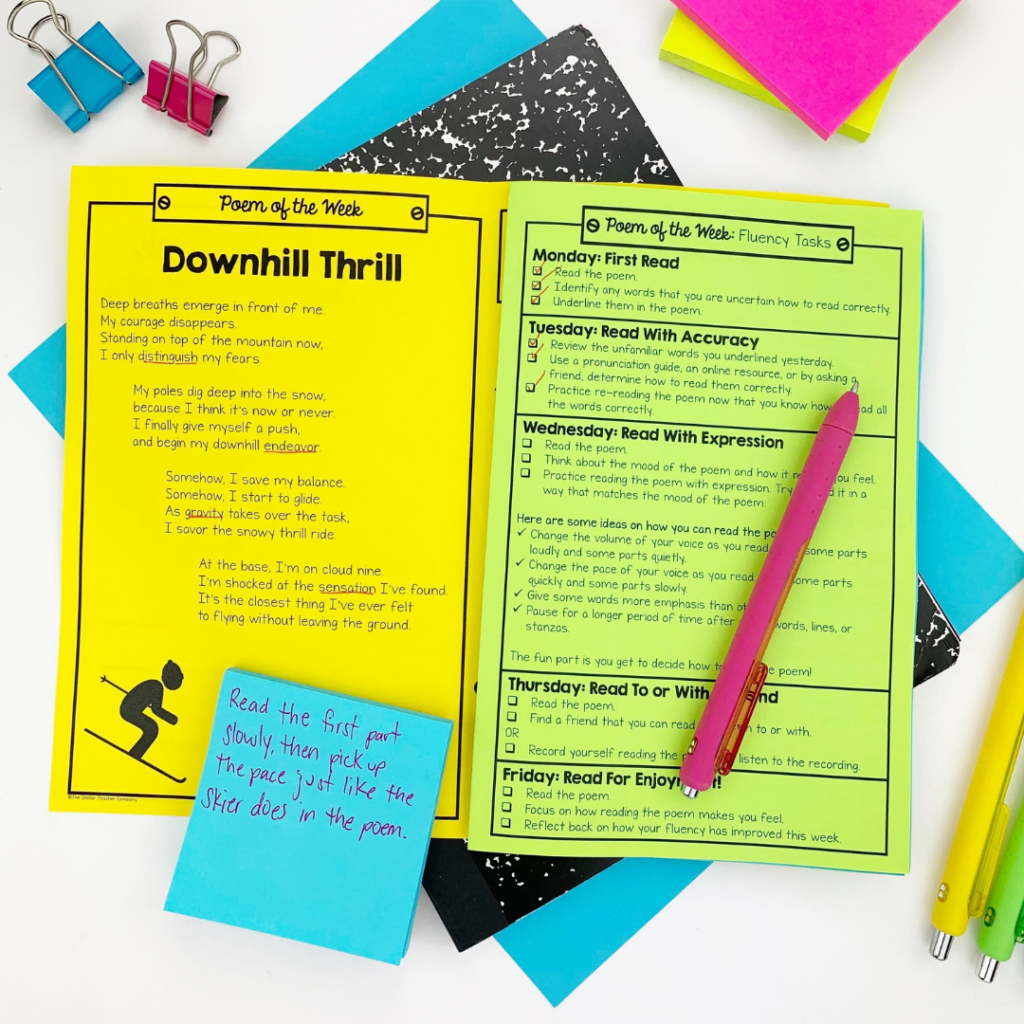
What is poem of the week?
Poem of the week is exactly what it sounds like. You pick one poem and you read and study it throughout the week. Rather than spending 30-40 minutes teaching your students EVERYTHING that is jam-packed into one poem, you read the poem and talk about just one small part each day, like the speaker, subject, or even word choice.
When you study the same poem for the entire week students have a chance to really feel confident in their ability to analyze the poem and understand it on a deeper level. Plus there are tons of benefits to reading poetry every day besides just comprehension.
How to plan/prepare for poem of the week?
Planning for poem of the week is simple. Simply find a poem for the week. You can copy it onto chart paper, display it on your smartboard, or give students their own copy to read and enjoy during the week. I do have a poem of the week resource that I’ll link to at the bottom of this blog post, but the poem of the week routine can be done with any poem.
Here are some of my favorite poetry anthologies:
- Lion of the Sky: Haiku for All Seasons by Laura Purdie Salas
- The Best Part of Me: Children Talk About Their Bodies in Pictures and Words by Wendy Ewald
- Once I Laughed My Socks Off: Poem for Kids by Steve Attewell
- Wet Cement: A Mix of Concrete Peoms by Bob Raczka
- My Thoughts are Clouds: Poems for Mindfullness by Georgia Heard
- African Acrostics: A Word in Edgeways by Avis Harley
Simply pick a poem that you think your students will enjoy and you have your poem of the week.
What are the benefits of poem of the week?
Poem of the week has so many benefits:
- Reading poetry can really help students with their fluency. There are opportuniteis to work on phrasing and expression and since poems are short, it is easy to reread them several times during the week.
- Reading poetry can be used as a way to build background knowledge for other subjects. You can find a poem that is connected or related to a science or social studies topic and read that before you teach the full lesson on that concept.
- Reading poetry can be a great way to engage and spark interest in your reluctant readers. If you have a student who is reluctant to read, maybe a poem will be just the thing to turn them into a reader. There are tons of poems that are fun, silly, creative, sad, emotional, deep, dark… whatever your students are into you can probably find a poem to connect to their interests.
- Poetry is a great way to help students build their inferential thinking skills. Making inferences is one of the most critical reading skills our stduents need. Poetry requires students to make inferences to really understand what is gonig on in the poem.
So other than reading the poem, what else should we do with poem of the week?
Great question and I’m so glad you asked. So with poem of the week, there are a TON of different reading skills you can focus on. Reading poetry can help with accuracy, interest, fluency, comprehension, you can even use poems to help build background knowledge.
But with limited time, I suggest you use poem of the week to really focus on two things: fluency and comprehension.
In the rest of this post, I’ll be focusing on how you can use a simple poem of the week routine to really help your students comprehend and understand poetry. Then be sure to check back here next week and I’ll be releasing another post that will break down the poem of the week fluency routine.
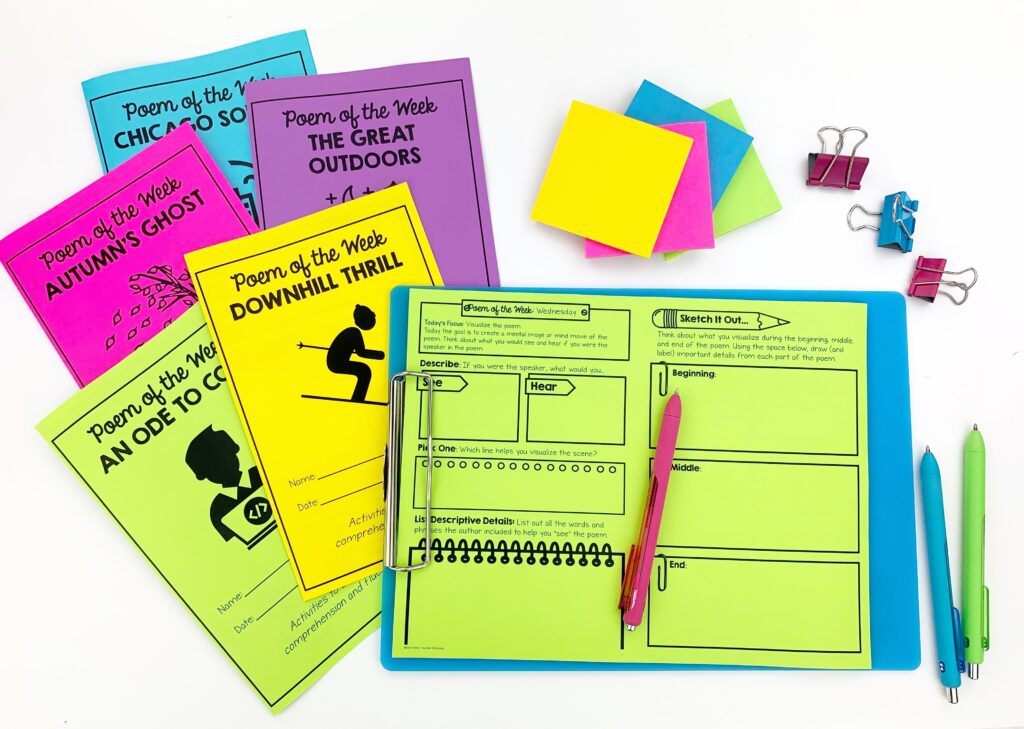
Poem of the Week: Comprehension Routine
There are tons of ways you can set up your poem of the week routine. Here are some ideas for how you could break down the week to provide a different comprehension focus each day.
Monday: Focus on Identifying Basic Elements of Poetry
The goal for Monday is for students to read the poem and develop a very basic understanding of what is happening in the poem. In order for students to dig really deep into the poem and identify the theme or consider the speaker’s point of view, they first need to make sure that they actually understand what the poem is about and who is speaking in the poem.
On Monday, these are some of the questions/tasks you could have your students consider:
- Identify the number of stanzas and lines.
- Look for a rhyme scheme or any repeated words.
- Identify who or what is speaking in the poem.
- Identify the subject or topic of the poem.
- Think about the mood of the poem – how does reading the poem make you feel?
And then the final thing I liked to ask my students on the first day is to consider if they actually enjoyed reading the poem. I think it’s important for students to feel like they have a voice and opinion when it comes to reading and anytime they can share their opinions and preferences just helps them feel more engaged in the reading experience.
Tuesday: Focus on Analyzing Word Choice
Word choice is such an important part of poetry. Authors are usually very limited with the words they can use in the poem so they are really intentional with the words they use. If authors are using a specific rhyme scheme or are writing a concrete poem, then it’s important for students to really think about and pay attention to the word choice.
A few things you could have students consider or pay attention to on Tuesday:
- Why do you think the author included the word ________ in the poem?
- Why do you think the author repeated the word ________ in the poem?
- Why did the author include the line ________?
- What do you think the author wants us to understand from reading the stanza?
- Why do you think the author chose to (bold, italicize, capitalize) the word _______ in the poem?
- Why did the author choose to space the words in this way in the poem?
All of these questions get students to pay close attention to the words in the poem which will help them think critically about the message the author is trying to communicate.
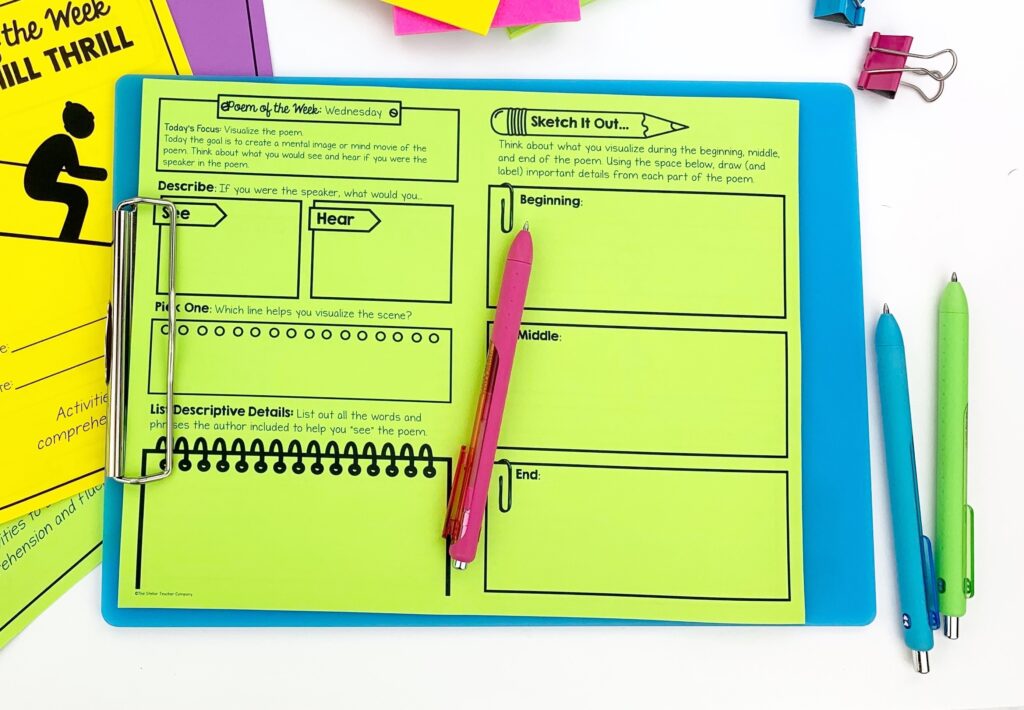
Wednesday: Visualize the Poem
On Wednesday, your students will spend time looking for details that will help them consider what they would see, hear, and feel if they were the speaker in the poem. Students will think about the setting of the poem and try to create a mental image of what they see in the poem.
Questions you can ask your students to help them visualize the poem:
- If you were the speaker, what would you see, hear, feel, and smell?
- Which line helps you visualize the setting of the poem?
- List out all the details or words that helped you create a mental image of the poem?
- What do you think the author wants you to visualize while you read this poem?
- What is happening in the beginining, middle, and end of the poem?
You could even have your students sketch out a scene of the poem or draw-label-caption an illustration to go with the poem.
Thursday: Digging Deep aka Consider Speaker’s Point of View and Find the Theme
So by Thursday, your students have read the poem a few times and should have a really solid understanding of what is happening in the poem. They should be able to recall the basic details included in the poem. So today, we want them to dig really deep into the poem.
This is the day that they will be making inferences, thinking about the speaker’s specific point of view, identifying the theme, and summarizing the poem. This day is pretty hefty and might take more time to get through.
Here are some questions you could ask your students to help them dig deep into the poem:
- What is one thing the poet TELLS you about the speaker? What text evidence supports your answer?
- What is one thing you can INFER about the speaker? What text evidence supports your answer?
- Describe the speaker’s point of view.
- What is the speaker’s point of view or opinion on the subject ove the poem? How do you know?
- What is a possible theme for the poem?
- Summarzie the poem.
These are the types of questions and task that students are usually assessed on for their state exam. But in order for students to be successful with these tasks, they need to have a basic understanding of the poem first. We often want to jump right to thinking about the deep stuff before we take time to build up our background knowledge and understanding of the poem.
Be sure to complete Monday – Wednesday’s tasks before jumping into Thursday.
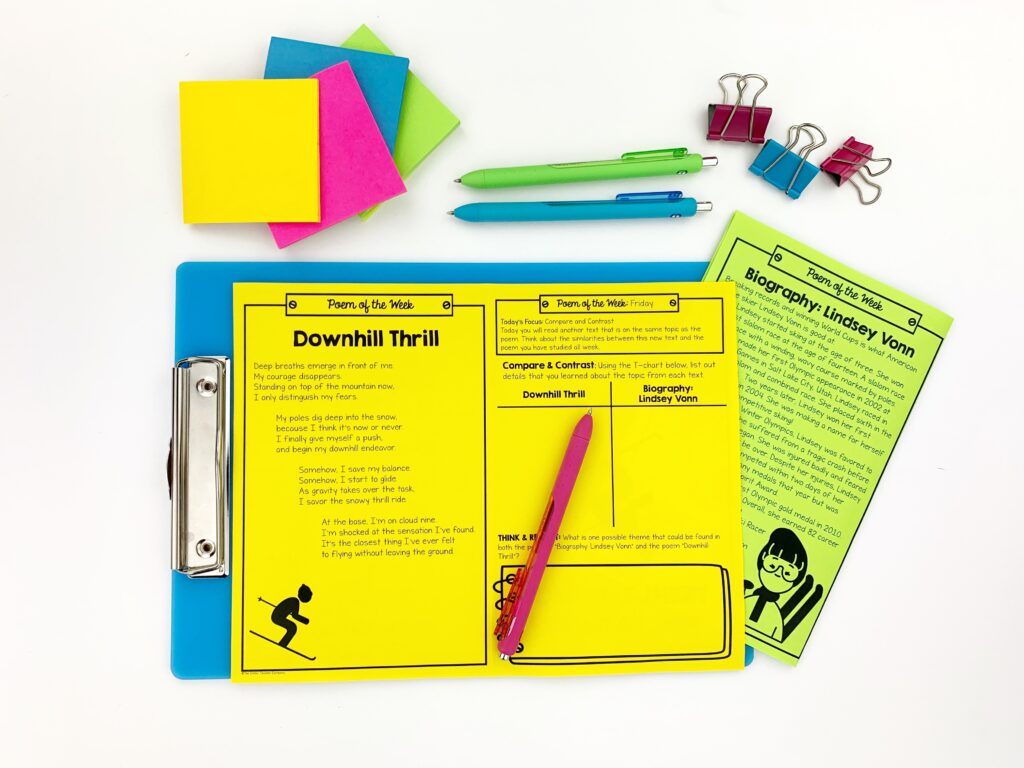
Friday: Compare & Contrast the Poem with Prose (or Another Poem)
One of the things I like to do is have students compare the poem they read during the week with another text. You could find a short story with a similar theme or setting or find a nonfiction article written on the same topic, or you could even find another poem written in the same style as the poem of the week.
In my poem of the week resource, we include a paired passage for students to compare to the poem.
Comparing and contrasting is a great skill to boost critical thinking and it is a great way to end the poem of the week routine.
Here are some questions you could ask your students if they are comparing another text to the poem.
- What did you learn from the poem?
- What did you learn from the other text?
- In what ways are the two texts similar?
- In what ways are the two texts different?
- What was the author’s purpose for writing each text?
- Which did you enjoy reading the most? Explain.
This day could be optional, but it is a great way to help students see the connection between poetry and other texts they read.
Are you ready to get started with Poem of the Week?
As you can see, poem of the week is a really easy routine to get started with and it is jam-packed with lots of reading and writing benefits. Don’t forget to check out my blog post next week where I will break down the poem of the week routine that will help your students improve their fluency.
Now the only thing that is left for you to do is go find a poem that you can use next week so your students can get started with poem of the week!
Happy Teaching!
I’ve got a free gift for you!
Favorite Genre Reading Flowchart
Help your students fall in love with reading with this fun and engaging flow chart. This flowchart is a twist on a classic reading inventory and will help students discover the type of book they should read next. Students can go through this reading flowchart several times and get different answers each time. It’s such a fun way to help students explore different genres.
This is such a fun tool to share with students anytime they are in a reading rut and are looking for new genres to explore.
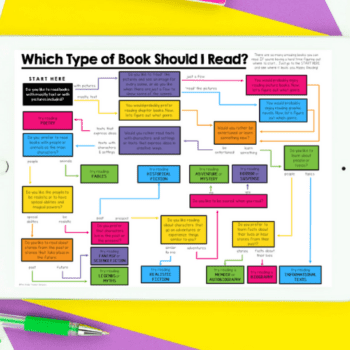


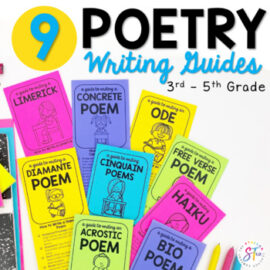
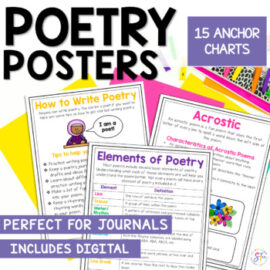
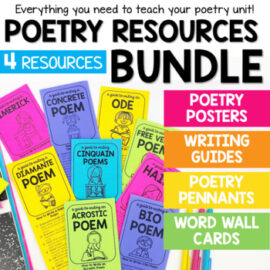
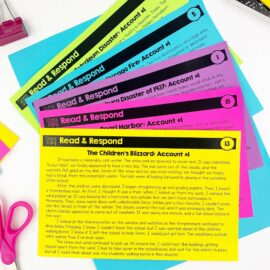
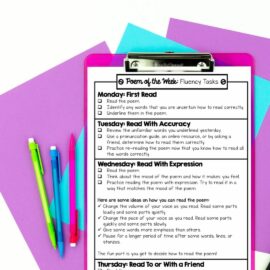










Leave a Comment
You must be logged in to post a comment.